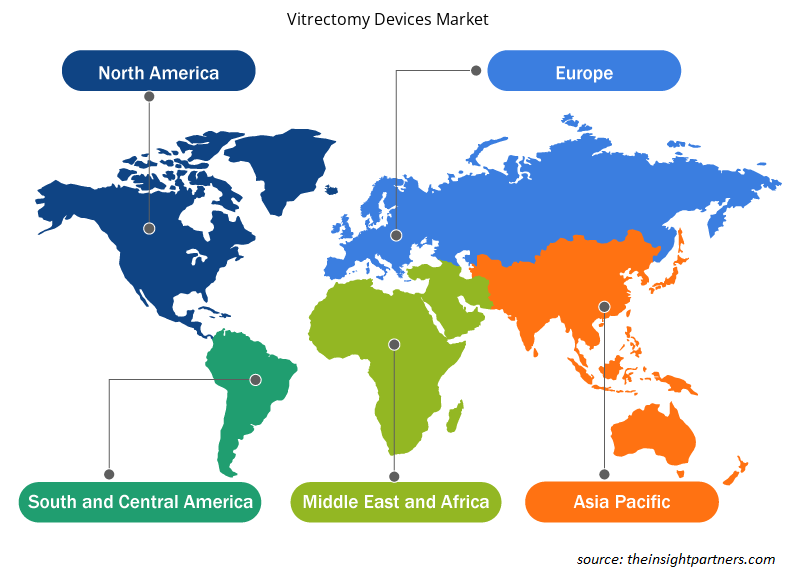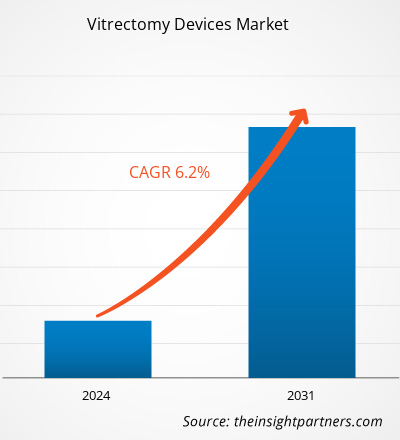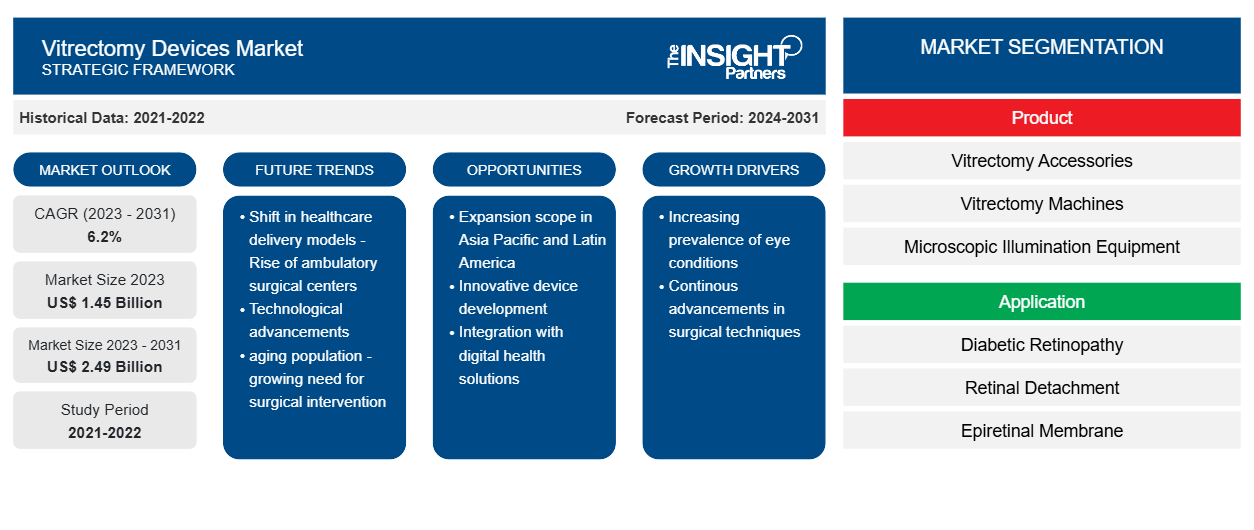Si prevede che la dimensione del mercato dei dispositivi per vitrectomia raggiungerà i 2,49 miliardi di dollari entro il 2031, rispetto agli 1,45 miliardi di dollari del 2023. Si prevede che il mercato registrerà un CAGR del 6,2% nel periodo 2023-2031.È probabile che l'elevato numero di approvazioni e lanci di prodotti continui a essere una tendenza fondamentale sul mercato.
Analisi di mercato dei dispositivi per vitrectomia
I fattori chiave che stanno guidando la crescita del mercato sono un aumento significativo della popolazione anziana e progressi significativi correlati ai dispositivi per la chirurgia vitreoretinica. Inoltre, il potenziale inutilizzato delle economie emergenti ha creato opportunità di crescita per il mercato dei dispositivi per la vitrectomia nel prossimo periodo di previsione. Ad esempio, con la maturazione dei mercati statunitense ed europeo, la maggior parte degli operatori sta spostando la propria attenzione sui mercati emergenti. Gli elevati investimenti nella ricerca sulle scienze della vita e sulla salute nei paesi emergenti svolgono un ruolo chiave nell'aggiornamento delle ultime tecnologie in questi paesi.
Panoramica del mercato dei dispositivi per vitrectomia
Diverse economie in tutto il mondo, come Stati Uniti, Regno Unito, Canada, Giappone, Cina, India e Corea del Sud, stanno assistendo a una notevole modernizzazione delle strutture sanitarie e a miglioramenti nei servizi sanitari. Con ciò, l'aspettativa di vita delle persone in questi paesi porta a una crescita della loro base di popolazione geriatrica. Come riportato dall'OMS (2018), si stima che la popolazione geriatrica salirà dal 12% nel 2015 al 22% entro il 2050. Inoltre, l'US Census Bureau afferma in un rapporto che si prevede che il numero di persone negli Stati Uniti di età pari o superiore a 65 anni crescerà da 46 milioni nel 2016 a oltre 98 milioni entro il 2060. La loro quota di popolazione crescerà da circa il 15% a circa il 24% durante questo periodo. Un altro rapporto, pubblicato da United Nation's World Population Ageing, afferma che l'Europa aveva la percentuale più alta al mondo (vale a dire, il 25%) di persone di età superiore ai 60 anni nel 2017. Inoltre, entro il 2050, tutte le regioni del mondo, eccetto l'Africa, avrebbero circa il 25% o più della loro popolazione di età pari o superiore ai 60 anni. Inoltre, i paesi sottosviluppati e in via di sviluppo rappresenterebbero circa l'80% di questa crescita.
Personalizza questo report in base alle tue esigenze
Riceverai la personalizzazione gratuita di qualsiasi report, comprese parti di questo report, o analisi a livello nazionale, pacchetto dati Excel, oltre a usufruire di grandi offerte e sconti per start-up e università
-
Scopri le principali tendenze di mercato in questo rapporto.Questo campione GRATUITO includerà analisi di dati che spaziano dalle tendenze di mercato alle stime e alle previsioni.
Driver e opportunità di mercato dei dispositivi per vitrectomia
Progressi significativi relativi ai dispositivi di chirurgia vitreoretinica
Nel corso degli anni, i requisiti specificati da una specialità relativamente nuova della chirurgia vitreoretinica hanno ispirato i progressi nella tecnologia delle apparecchiature per la vitrectomia. I continui progressi nella tecnologia e nella strumentazione hanno portato a una riduzione delle incisioni e a una stabilizzazione più rapida delle ferite. La conoscenza della storia e dei driver degli sviluppi tecnologici aiuta i pionieri della chirurgia e l'industria a continuare a lavorare insieme per generare progressi tecnologici tanto necessari. Varie ricerche sulla fluidica, sui tassi di taglio, sulle modalità di attuazione e su altri aspetti funzionali hanno portato alla miniaturizzazione dei dispositivi per la vitrectomia. Questo fattore ha migliorato la sicurezza consentendo anche la creazione di efficienze utilizzando sonde per vitrectomia di calibro inferiore.
Il potenziale inutilizzato delle economie emergenti
Si prevede che la crescente domanda di interventi di cataratta, refrattivi e vitrectomia aumenterà le vendite di dispositivi per vitrectomia. I principali attori del mercato stanno aumentando la loro penetrazione nei mercati emergenti espandendo le loro reti di distribuzione e aumentando le capacità di produzione. Si prevede che i mercati emergenti in India, Corea del Sud, Brasile e Messico offriranno potenziali opportunità di crescita per i principali produttori di dispositivi per vitrectomia negli anni a venire. Ciò può essere attribuito alla vasta popolazione di pazienti, all'elevata prevalenza di malattie oculari , come cataratta e altri problemi di vista, all'aumento del reddito disponibile, al miglioramento delle infrastrutture sanitarie e al crescente turismo medico in questi paesi. Questo fattore, a sua volta, supporta l'inclinazione verso gli interventi di vitrectomia
Analisi della segmentazione del rapporto di mercato sui dispositivi per vitrectomia
I segmenti chiave che hanno contribuito alla derivazione dell'analisi di mercato dei dispositivi per vitrectomia sono il prodotto, l'applicazione, il tipo di paziente, l'approccio chirurgico, il canale di distribuzione e l'utente finale.
- In base al prodotto, il mercato dei dispositivi per la vitrectomia è segmentato in accessori per la vitrectomia, macchine per la vitrectomia, apparecchiature di illuminazione microscopica, strumenti chirurgici e altri. Il segmento del sistema di invio assistito da computer (CAD) EMS ha detenuto una quota di mercato maggiore nel 2023.
- Per applicazione, il mercato è segmentato in retinopatia diabetica, distacco di retina, membrana epiretinica, foro maculare e altri. Il segmento della retinopatia diabetica ha detenuto la quota maggiore del mercato nel 2023.
- Per tipologia di paziente, il mercato è segmentato in adulti, pediatria, geriatria. Il segmento degli adulti ha detenuto la quota maggiore del mercato nel 2023.
- In base all'approccio chirurgico, il mercato è segmentato in vitrectomia posteriore/pars plana, vitrectomia anteriore. Il segmento della vitrectomia posteriore/pars plana ha detenuto la quota maggiore del mercato nel 2023.
- In base all'utente finale, il mercato dei dispositivi per vitrectomia è segmentato in ospedali, cliniche oftalmologiche, centri chirurgici ambulatoriali (ASC). Il segmento ospedaliero ha detenuto una quota di mercato maggiore nel 2023.
Analisi della quota di mercato dei dispositivi per vitrectomia per area geografica
L'ambito geografico del rapporto sul mercato dei dispositivi per vitrectomia è suddiviso principalmente in cinque regioni: Nord America, Asia Pacifico, Europa, Medio Oriente e Africa, e Sud e Centro America.
Gli Stati Uniti sono il più grande mercato per i dispositivi di vitrectomia a livello mondiale, la posizione di leader di questo segmento è attribuita a molteplici fattori come l'aumento della popolazione geriatrica e la prevalenza di malattie oculari della retina. Inoltre, in termini di tecnologia, la nazione è molto più avanti rispetto ad altri paesi sviluppati ed emergenti. I progressi nella tecnologia hanno portato allo sviluppo di vari dispositivi di vitrectomia e tecnologie che vengono utilizzati per le loro applicazioni. Negli Stati Uniti, il numero di vitrectomie è aumentato in modo significativo negli ultimi anni. Inoltre, lo sviluppo della tecnologia ha aumentato il numero di procedure minimamente e non invasive . Ad esempio: secondo la US National Library of Medicine, circa 2.25.000 vitrectomie vengono eseguite ogni anno negli Stati Uniti e le indicazioni continuano ad espandersi.
Approfondimenti regionali sul mercato dei dispositivi per vitrectomia
Le tendenze regionali e i fattori che influenzano il mercato dei dispositivi per vitrectomia durante il periodo di previsione sono stati ampiamente spiegati dagli analisti di Insight Partners. Questa sezione discute anche i segmenti e la geografia del mercato dei dispositivi per vitrectomia in Nord America, Europa, Asia Pacifico, Medio Oriente e Africa e Sud e Centro America.

- Ottieni i dati specifici regionali per il mercato dei dispositivi per vitrectomia
Ambito del rapporto di mercato sui dispositivi per vitrectomia
| Attributo del report | Dettagli |
|---|---|
| Dimensioni del mercato nel 2023 | 1,45 miliardi di dollari USA |
| Dimensioni del mercato entro il 2031 | 2,49 miliardi di dollari USA |
| CAGR globale (2023-2031) | 6,2% |
| Dati storici | 2021-2022 |
| Periodo di previsione | 2024-2031 |
| Segmenti coperti |
Per Prodotto
|
| Regioni e Paesi coperti |
America del Nord
|
| Leader di mercato e profili aziendali chiave |
|
Densità degli attori del mercato: comprendere il suo impatto sulle dinamiche aziendali
Il mercato dei dispositivi per vitrectomia sta crescendo rapidamente, spinto dalla crescente domanda degli utenti finali dovuta a fattori quali l'evoluzione delle preferenze dei consumatori, i progressi tecnologici e una maggiore consapevolezza dei benefici del prodotto. Con l'aumento della domanda, le aziende stanno ampliando le loro offerte, innovando per soddisfare le esigenze dei consumatori e capitalizzando sulle tendenze emergenti, il che alimenta ulteriormente la crescita del mercato.
La densità degli operatori di mercato si riferisce alla distribuzione di aziende o società che operano in un particolare mercato o settore. Indica quanti concorrenti (operatori di mercato) sono presenti in un dato spazio di mercato in relazione alle sue dimensioni o al valore di mercato totale.
Le principali aziende che operano nel mercato dei dispositivi per vitrectomia sono:
- Quark Software Inc.
- Servizi offerti da AngelTrack LLC
- Gruppo Trapezio
- Società Cerner
- Assistenza sanitaria GE
- PIAZZA CENTRALE
Disclaimer : le aziende elencate sopra non sono classificate secondo un ordine particolare.

- Ottieni una panoramica dei principali attori del mercato dei dispositivi per vitrectomia
Notizie di mercato e sviluppi recenti sui dispositivi per vitrectomia
Il mercato dei dispositivi per vitrectomia viene valutato raccogliendo dati qualitativi e quantitativi post-ricerca primaria e secondaria, che includono importanti pubblicazioni aziendali, dati di associazioni e database. Di seguito sono elencati alcuni degli sviluppi nel mercato dei dispositivi per vitrectomia:
- DORC International ha annunciato l'acquisizione di Peregrine Surgical LLC e l'acquisizione della piena proprietà di WEFIS GmbH a seguito di un investimento azionario iniziale annunciato all'inizio del 2022. Entrambe le acquisizioni estendono significativamente le capacità di produzione e innovazione dell'azienda, ampliando al contempo la portata geografica e la velocità di commercializzazione della strategia di DORC. (Fonte: DORC, sito Web aziendale, novembre 2022)
- DORC lancia il nuovo sistema di cannule EVA Trocar (commercializzato come EVA AVETA al di fuori degli Stati Uniti). EVA Trocar è il primo sistema a presentare la connessione di infusione Push-Fit in attesa di brevetto, oltre a un'esclusiva funzione di ritenzione incisa al laser. (Fonte: DORC, sito Web aziendale, aprile 2022)
Copertura e risultati del rapporto di mercato sui dispositivi per vitrectomia
Il rapporto "Dimensioni e previsioni del mercato dei dispositivi per vitrectomia (2021-2031)" fornisce un'analisi dettagliata del mercato che copre le seguenti aree:
- Dimensioni e previsioni del mercato dei dispositivi per vitrectomia a livello globale, regionale e nazionale per tutti i principali segmenti di mercato coperti dall'ambito
- Tendenze del mercato dei dispositivi per vitrectomia e dinamiche di mercato come driver, sistemi di ritenuta e opportunità chiave
- Analisi dettagliata delle cinque forze PEST/Porter e SWOT
- Analisi di mercato dei dispositivi per vitrectomia che copre le principali tendenze del mercato, il quadro globale e regionale, i principali attori, le normative e i recenti sviluppi del mercato.
- Analisi del panorama industriale e della concorrenza che copre la concentrazione del mercato, l'analisi della mappa di calore, i principali attori e gli sviluppi recenti per il mercato dei dispositivi per vitrectomia
- Profili aziendali dettagliati
- Analisi storica (2 anni), anno base, previsione (7 anni) con CAGR
- Analisi PEST e SWOT
- Valore/volume delle dimensioni del mercato - Globale, Regionale, Nazionale
- Industria e panorama competitivo
- Set di dati Excel
Report recenti
Testimonianze
Motivo dell'acquisto
- Processo decisionale informato
- Comprensione delle dinamiche di mercato
- Analisi competitiva
- Analisi dei clienti
- Previsioni di mercato
- Mitigazione del rischio
- Pianificazione strategica
- Giustificazione degli investimenti
- Identificazione dei mercati emergenti
- Miglioramento delle strategie di marketing
- Aumento dell'efficienza operativa
- Allineamento alle tendenze normative























 Ottieni un campione gratuito per - Mercato dei dispositivi per vitrectomia
Ottieni un campione gratuito per - Mercato dei dispositivi per vitrectomia